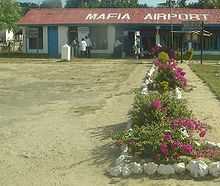Mafia Island
 Administrative map (divisions, wards, and villages) | |
| Geography | |
|---|---|
| Adjacent bodies of water | Indian Ocean |
| Area | 435 km2 (168 sq mi) |
| Length | 49 km (30.4 mi) |
| Width | 17 km (10.6 mi) |
| Highest elevation | 53 m (174 ft) |
| Country | |
|
Tanzania | |
| Demographics | |
| Population | 40,801 (as of 2002) |
Mafia Island ("Chole Shamba") is part of the Tanzanian Zanzibar Archipelago, together with Unguja, Pemba and Latham Island. As one of the six districts of the Pwani Region, Mafia Island is governed from the mainland, not from the semi-autonomous region of Zanzibar, of which it has never been considered to be a part.
According to the 2002 Tanzania census, the population of the Mafia District was 40,801.[1] The economy is based on fishing, subsistence agriculture and the market in Kilindoni. The island attracts some tourists, mainly adventure scuba divers, game fishermen, and people wanting relaxation.
Geography
The Mafia archipelago consists of one large island (394 km²) and several smaller ones. Some of these are inhabited, such as Chole Island (2 km²), with a population of 800. Chole Bay, Mafia's protected deep-water anchorage and original harbour, is studded with islands, sandbanks and beaches. The main town is Kilindoni. The stretch of water between the deltas of the Rufiji River and the island is called Mafia Channel. There are popular rumours of pygmy hippo on the island but there are no confirmed sightings.
History
Mafia Island's history goes back to the 8th century. The island once played a major role in ancient trade between the people of the Far East and East Africa. It was a regular stop for Arab boats. On the tiny island of Chole Mjini, just offshore in Chole Bay, once stood a settlement that constituted one of the most important towns controlling trade from the silver mines of Eastern Zimbabwe, which reached the town via the old ports of Kilwa and Michangani.
In the mid-1820s, the town of Kua on Juani Island was attacked by Sakalava cannibals arriving from Madagascar with 80 canoes, who ate many of the locals and took the rest into slavery.[citation needed]
Under a treaty of 1890, Germany took control of Mafia and constructed the buildings still evident on Chole. Germany paid Sultan Sayyid Ali bin Said al-Said of Oman M 4 million for both the island and part of the mainland coast. In January 1915, Mafia was taken by British troops as a base for the air and sea assault on the light cruiser Königsberg.
The name "Mafia" derives from the Arabic morfiyeh, meaning "group" or "archipelago", or from the Swahili mahali pa afya, meaning "a healthy dwelling-place".
In 1995 Mafia Island had financial help from the WWF to make a natural marine wildlife centre. The organization continued to provide support to the Island under Rufiji-Mafia-Kilwa (RUMAKI) seascape project to improve socio-economic well-being of the communities through the sustainable, participatory and equitable utilization and protection of their natural resources. Under the current EU-WWF Fisheries Co-management Project, the organization aims at building effective long-term fisheries co-management through establishment of 10 Beach Management Units and to continue supporting Village Community Banks (VICOBA) in the Island to generate optimal, sustainable and equaitable livelihood benefits, and which provide a source of lesson-learning for other costal communities.The WWF Mafia office is under three technical staff - Paul Kugopya (Mafia Fisheries Co-management Officer), Marko Gideon (EU-WWF Fisheries Co-management Project Communication/Awareness Officer) and Renatus Rwamugira (Project Accountant for Mafia).
Tanzania's first multi-user marine park at Mafia Island was established following management recommendations and data from surveys conducted by the Society for Environmental Exploration.[2]
Administration

The Mafia District is administratively divided into 7 wards, listed with area and population:[3]
| Ward | Area km² | Population 2002 | Villages |
|---|---|---|---|
| Baleni | 132.1 | 9,137 | Baleni, Kungwi, Ndagoni, Chunguruma |
| Jibondo | 21.9 | 3,405 | Jibondo, Chole, Juani |
| Kanga | 52.7 | 3,317 | Kanga, Bweni |
| Kilindoni | 36.8 | 11,696 | Kilindoni, Dongo |
| Kirongwe | 77.0 | 5,260 | Kirongwe, Jimbo, Banja, Jojo |
| Kiegeani | 40.3 | 3,379 | Kiegani, Marimbani |
| Mibulani | 52.3 | 4,363 | Miburani, Mlongo, Chemchem |
| Mafia Island | 413 | 40,801 | 20 villages |
See also
Image gallery
-
.jpg)
A map of Tanzania showing Mafia Island
-
Districts of Pwani Region showing Mafia District
-

Historical nautical chart
-

Harbour of Mafia Island as seen from a departing boat.
Sources
References
- Chami, F. A. 1999. “The Early Iron Age on Mafia island and its relationship with the mainland.” Azania Vol. XXXIV 1999, pp. 1–10.
- Chami, Felix A. 2002. “The Graeco-Romans and Paanchea/Azania: sailing in the Erythraean Sea” by Felix A. Chami. From: Red Sea Trade and Travel. The British Museum. Organised by The Society for Arabian Studies. Downloaded on 20 July 2003 from: http://www.thebritishmuseum.ac.uk/ane/fullpapers.doc
Coordinates: 7°51′S 39°47′E / 7.850°S 39.783°E
